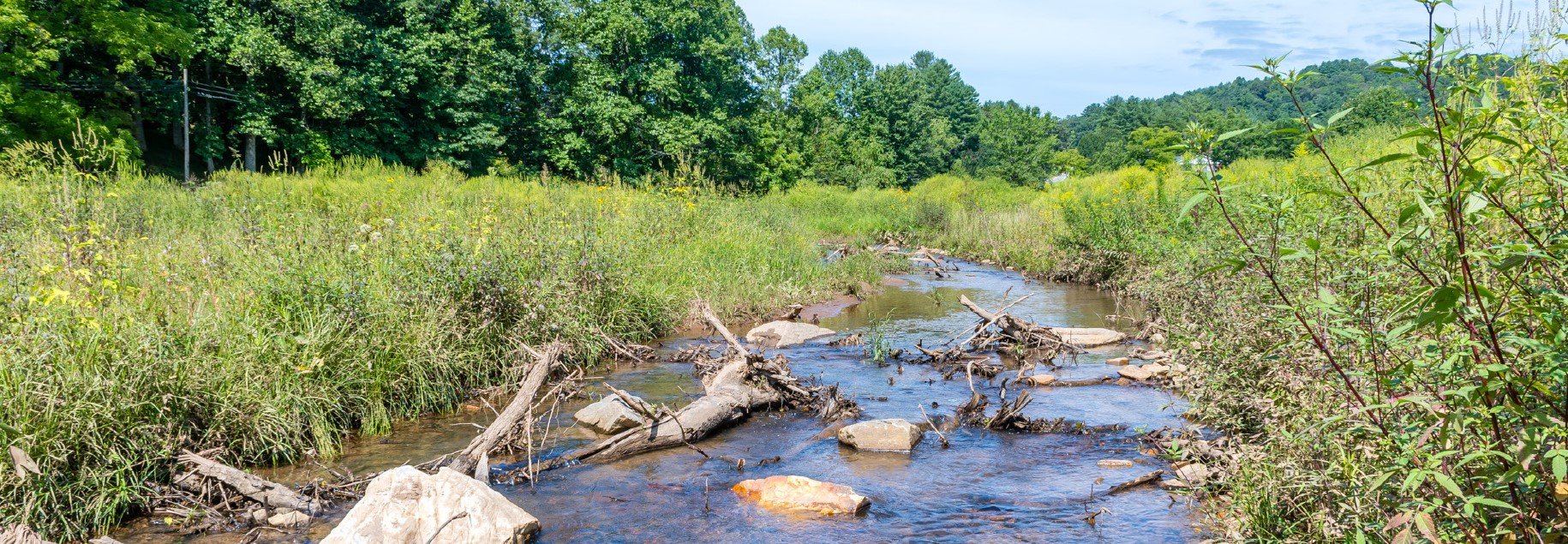Resource Institute and partners restored and stabilized a reaches of Hog Lot Branch and Bates Branch near Franklin, North Carolina.
Franklin, North Carolina
Are hellbenders in a stream near you? Resource Institute recently completed a stream restoration project on Hog Lot Branch and Bates Branch near Franklin, North Carolina. Both reaches of the stream were severely eroding, and agriculture production was impacted. The project team restored 1,250 feet of stream, which included stabilizing the creek and streambanks and creating habitat for a variety of species, including hellbenders, which were last sighted in Bates Branch in 2003.
A hellbender taking refuge under a rock.
The hellbender, the largest salamander in North America, is native to the eastern and central United States. They typically live under large rocks or boulders partially buried in cold, fast-flowing streams. These rocks provide protection from predators, and hellbenders may abandon a habitat if the rocks are removed or disturbed. (National Wildlife Federation)
Morgan Harris, a biologist with the Southeastern Hellbender Conservation Initiative and the Conservation Management Institute at Virginia Tech, assess Bates Branch for hellbenders and hellbender habitat.
When the project began, the team consulted with Morgan Harris, a biologist with the Southeastern Hellbender Conservation Initiative and the Conservation Management Institute at Virginia Tech. Harris worked with engineers at Michael Baker International to incorporate hellbender habitat into the restoration plans.
The project team rebuilt the channel with meandering bends and installed instream rock and toe wood structures. To encourage hellbenders, the team added big flat rocks that are slightly elevated from the bottom so that there is a large enough cavity to lay and guard eggs as well as make a home in and around the rock clusters. Lastly, the team established a wooded riparian buffer along both sides of the stream. Alan Walker, Resource Institute, says, “The riparian buffer is critical for all aquatic species on Hog Lot and Bates Branch from macroinvertebrates on up, including hellbenders.”
Eroding streambanks on Bates Branch prior to restoration.
The project assessment, design, and construction required a team with a diverse set of skills and experience. Resource Institute managed the project, leveraging funding from the NC Department of Water Resources, NC Land Water & Fund, and NRCS, Macon Soil & Water Conservation District worked locally with the landowners, Michael Baker International designed the restoration plans, and Penland Contracting constructed the project with Belflower Construction performing the riparian planting.
Resource Institute and the Macon Soil & Water Conservation District are currently working to identify new sites for restoration. Harris says, “Macon County restoration projects are critical. Little Tennessee south of Franklin is really in bad shape; any restoration will keep a lot of species alive. Protecting these tributaries is genuinely important.”
The project team planted 460 trees and 2,500 live stakes and shrubs. The plantings will enhance aquatic and wildlife habitat and aid streambank stabilization. The riparian planting will also contribute to carbon sequestration. Over ten years, the plantings will sequester 23 tons of carbon. Overall, the project will reduce sediment in the stream by 75 tons per year.




